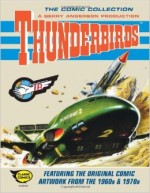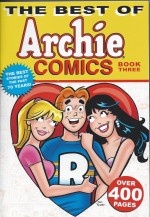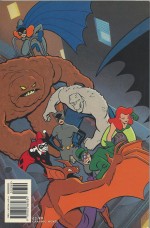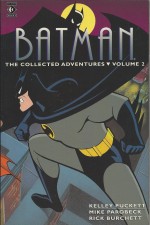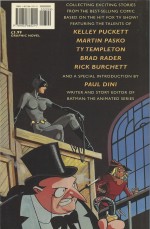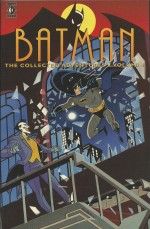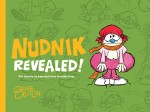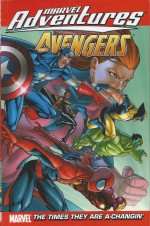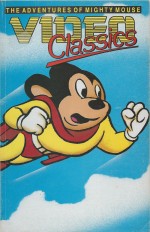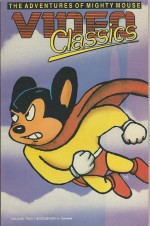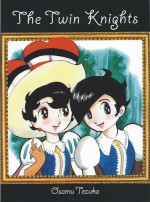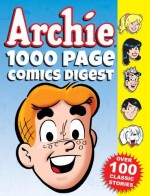
By various (Titan Comics)
ISBN: 978-1-87276-032-0
Win’s Christmas Gift Recommendation: An X-mas tradition in the making… 10/10
Hard though it is to believe, Wallace & Gromit have been delighting us for nearly 25 years and this extremely engaging compilation perfectly attests to just how much a cornerstone of British culture the potty putty pair have become.
The ingenious, quintessentially English cheese-chasing chaps were originally conceived as an ArtSchool graphic novel for the student Nick Park, before the Plasticene lure of movement and sound diverted the concept to the world of animation.
Now a multi-media success, the animator’s ingenious inventors have come full circle with this compelling compilation of the newspaper comic strip adaptation spawned by their small (and big) screen endeavours.
According to the informative Foreword by Nick Park, in his youth the affable creator was a big fan of comics, newspaper strips and those gloriously fun-filled Christmas Annuals, so this book, incorporating all three, must be a big boost to the old glee muscles…
After years of perpetually waiting for more Wallace & Gromit, the public were given a big treat after Aardman and Titan Comics put their collective creative noggins together and produced a daily, full-colour comic strip to run in Red-Top tabloid The Sun.
The series was produced by committee and actually actualised (for this edition at least) by scripters Richy Chandler, Robert Etherington, Ned Hartley, Rik Hoskin, David Leach, J.P. Rutter and Rona Simpson, with Gordon Volke, Mike Garley, & Luke Paton with art by Jimmy Hansen & Mychailo Kazybrid, Sylvia Bennion, Jay Clarke, Viv Heath & Brian Williamson, inked by Bambos Georgiou with colours by John Burns & Digikore.
The rather complex creative process is explained in the closing essay ‘Tomb of the Unknown Artist’ if you’re of an inquiring technical nature…
Despite some early controversy about the suitability of the venue, the feature launched on Monday 17th May, 2010, cleverly offering a regular weekly adventure broken down into six, complete, stand-alone gags in traditional format (three panels: Set-up, Delivery, Punchline!). What could be better?
The tone is bright and breezy, inventive family fare with all the established characters in play and the emphasis equally on weird science and appalling puns.
…And Cheese, buckets and buckets of fermented milk-curd mirth…
Dedicated to the further adventures of Northern boffin Wallace and the incomparable best-of-breed working dog Gromit, and set as ever in and around scenic 62 West Wallaby Street, Wigan, the first six-day week reveals that ‘The Tooth Hurts’ in a painful progression from agonised impacted wisdom tooth through the construction of an oddly automated – and frankly terrifying – “Cavitron†to a more traditional extraction thanks to the dog’s sensibly take-charge attitude.
This is promptly followed by similar results from the construction of washing-up robot ‘Helping Hands’, sound amplifying ‘Hear Muffs’ and the first of a dozen double-page spread photo pin-ups taken from the original animated features.
Then ever-peckish Wallace attempts to update the ancient science of apiary in ‘Knowing Bee, Knowing You’, builds his own T-Rex in ‘Jurassic Lark’, “helps†Gromit solve the mystery of missing milk with the overzealous ‘Roboplod’ and even catch a tragic dognapper in ‘Pet Detectives’…
There’s a wealth of delightful in-jokes scattered throughout the strips such as scholarly Gromit’s quirky reading habits (The Dog Delusion by Richard Pawkins, Paws by Peter Barkly, Cracking Cakes by Nigella Pawson or On the Origin of Species by Charles Darwinalot…) as well as a glorious parade of pained and hangdog expressions on the permanently perplexed pooch’s puss.
After another tasty photo-spread the lads go into ‘The Restaurant’ business with their Cheesy Way Diner, get into a bit of a kerfuffle with long-suffering Reg and Ida from ‘The House Next Door’, herald the pastapocalypse with an ultimate noodle maker that triggers ‘The Spaghetti Incident’ after which the lucky dog discovers the lost city of Wallabyzantium under the house in ‘Raiders of the Lost Bark’…
Another pin-up heralds a commission to fix the clock tower chronometer in ‘Gromit Time’ whilst ‘Life’s a Beach’ introduces rival tinkerer Otto Bahn mit his hund Wulfie at the European Inventor’s Convention, before the appallingly keen Sharp-sichord quickly graduates from honing pencils to bigger challenges in ‘Wallace’s Sharp Idea’ and football is forever changed by the old fool’s Robo-goalie in ‘A Safe Pair of Hands’.
The sport of cheese-rolling was easy meat for Wallace in ‘The Edam Busters’ after which a series of unconnected one-off strips comprising ‘Funnies #1’ is followed by the return of penguin super-thief Feathers McGraw in ‘Jolley-Goode Jewels’, the advent of ruthless twitcher Albert Ross in ‘Watch the Birdy’ and a foray into automated barber-ism in ‘A Snip Above’
Feathers made a break for it in ‘It Had to be Zoo’ whilst Wallace was beta-testing his robot-muck-spreader, and the inventor made quite a splash in his new day-job as a chauffeur ‘Driving Miss Crazy’, before Gromit registered extreme discontentment with his instant-self-assembly kennel in ‘Gone Camping’.
The lads celebrated Halloween as paranormal investigators of a haunted school in ‘Ghostblusters’, before all that cheese got to Wallace and Gromit put him on a diet in ‘A Fridge Too Far’. Then, following some more solo ‘Funnies #2’, there was monkey business aplenty when an ape went ‘Bonkers About Conkers’ before ‘A Family Affair’ unearthed a tradition for innovation in our pair’s inspirational ancestors…
The threat of Ballroom Dancing with Wendolene prompts the construction of another ill-advised training robot in ‘Strictly Wallace’, and greedy impatience the building of a ‘Cake-While-You-Wait’ oven, before the far more efficient ‘12 6 Days of Christmas’ celebrates the season with speedily surreal succinctness, after which a half-dozen ‘Breakfast Gags’ usher in a new year rife with catastrophic potential…
The restless dilettante then improves winter sports with jet-pack technology in ‘Ice to See You’, safeguarded Reg and Ida’s sowing season with the accidentally sinister ‘Scarecrowmatic’ and builds a Caddy-Matic contraption to take the dullness out of golf in ‘Hole in One (Hundred)’, going on to sculpt ice statues and an ‘Abominable Snowman’ before retiring with a ‘Perfect Cuppa’ courtesy of a jury-rigged Teasmaid-from-Hell…
Another cash shortfall leads to a dalliance with the arts in ‘Bona Lisa’ whilst an overabundance of soft fruit inspires a domestic mechanised revolution in ‘Bit of a Jam’, after which Albert Ross returns to squash Wallace’s sky-writing enterprise in ‘Love is in the Air’. Gromit then wants a bit of help protecting nest boxes from predatory moggies and Wallace’s solution is certainly ‘For the Birds’…
Disappearing dairy comestibles prove that ‘Sweet Dreams are made of Cheese’ and poor TV reception requires ‘Another Grand Day Out’ to clear space of accumulated junk – good thing they had that old rocket lying about – but autumnal clutter needs a more hands-on approach in ‘Leaf it to Wallace’, whilst the bonkers boffin’s attempts to mechanise newspaper delivery don’t work so well for Gromit the ‘Paper Hound’…
There were too many strings attached to ‘The Pup-Pet Show’ for the impecunious innovator, but a complete overhaul of Mr. Braddle’s little enterprise into ‘The Hard Work Hardware Shop’ paid big dividends, leaving time for a little fishing break in ‘Hook, Line and Stinker’ but it’s soon back to business when Feathers set his beady eye on the ‘The Faver-Heigh Egg’ belonging to a crusty colonel…
The chaps’ attempt to put up the official town bunting for the Queen’s visit lead to ‘A Right Royal Knees Up’ after which a Mayoral Fancy Dress affair offers real rewards for the brace of ‘Caped Crusaders’ and this initial barrage of batty bewilderments concludes with one more snack break as the boys adapt their removals firm to the needs of a catering crisis in ‘Movers and Shakers’…
Lovingly rendered and perfectly timed, the skilful blend of low comedy and whimsy is just as memorable in two dimensions as four, and this book will make a lot of kids – of all ages – extremely happy. Moreover, for all those parents who deliberately avoided the strip because of the paper which carried it, you no longer have that excuse and should now consider this annual collection a “must have†for your family bookshelf…
WALLACE & GROMIT, AARDMAN, the logos and all related characters and elements are © and ™ Aardman/Wallace & Gromit Ltd. 2013. All rights reserved.

